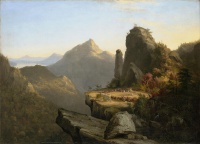United States
From The Art and Popular Culture Encyclopedia
|
"He who would become or remain an American must look on life as a struggle and not as a pleasure; he must count victorious effort and energetic arid efficient action more than ease, more than that leisure adorned by artistic and refined culture which is sought after in other societies."--La Vie américaine (1892) by Paul de Rousiers "When America found itself having a hard time facing the future, they looked for people like John Wayne. But since John Wayne was no longer available, they settled for Ronald Reagan."--"B-movie" (1981) by Gil Scott-Heron |



|
Related e |
|
Featured: |
The United States of America (USA), most often referred to simply as the United States or US, is a democratic republic in North America. Established in the 1770s as a collection of break-away English colonies, the United States has since eclipsed its mother nation and most other nations in terms of relative economic, political, military and arguably cultural importance. The end of the Cold War and the dissolution of the Soviet Union left the United States as the sole superpower. Because of this, the United States has often been accused of economic, political, military and cultural imperialism.
Contents |
Culture
The United States is home to many cultures and a wide variety of ethnic groups, traditions, and values. Aside from the relatively small Native American and Native Hawaiian populations, nearly all Americans or their ancestors settled or immigrated within the past five centuries. Mainstream American culture is a Western culture largely derived from the traditions of European immigrants with influences from many other sources, such as traditions brought by slaves from Africa. More recent immigration from Asia and especially Latin America has added to a cultural mix that has been described as both a homogenizing melting pot, and a heterogeneous salad bowl in which immigrants and their descendants retain distinctive cultural characteristics.
Core American culture was established by Protestant British colonists and shaped by the frontier settlement process, with the traits derived passed down to descendants and transmitted to immigrants through assimilation. Americans have traditionally been characterized by a strong work ethic, competitiveness, and individualism, as well as a unifying belief in an "American Creed" emphasizing liberty, equality, private property, democracy, rule of law, and a preference for limited government. Americans are extremely charitable by global standards. According to a 2006 British study, Americans gave 1.67% of GDP to charity, more than any other nation studied, more than twice the second place British figure of 0.73%, and around twelve times the French figure of 0.14%.
American culture is considered the most individualistic in the world. The American Dream, or the perception that Americans enjoy high social mobility, plays a key role in attracting immigrants. Social mobility is actually lower than other high-income countries, with the OECD ranking the U.S. 10th behind France, Germany, Canada, Australia, and the Nordic countries, This has been partly attributed to the depth of American poverty, which leaves poor children starting especially far behind. Such studies are based on relative comparisons within each nation rather than absolute wealth earned throughout one's life, the U.S. having both a more stretched-out income distribution and a higher income than those nations. While the mainstream culture holds that the United States is a classless society, scholars identify significant differences between the country's social classes, affecting socialization, language, and values.
Americans' self-images, social viewpoints, and cultural expectations are associated with their occupations to an unusually close degree. While Americans tend greatly to value socioeconomic achievement, being ordinary or average is generally seen as a positive attribute.
Popular media
The world's first commercial motion picture exhibition was given in New York City in 1894, using Thomas Edison's Kinetoscope. The next year saw the first commercial screening of a projected film, also in New York, and the United States was in the forefront of sound film's development in the following decades. Since the early 20th century, the U.S. film industry has largely been based in and around Hollywood, California.
Director D. W. Griffith was central to the development of film grammar and Orson Welles's Citizen Kane (1941) is frequently cited as the greatest film of all time. American screen actors like John Wayne and Marilyn Monroe have become iconic figures, while producer/entrepreneur Walt Disney was a leader in both animated film and movie merchandising. Hollywood is also one of the leaders in motion picture production.
In 1938, Superman, the quintessential comic book superhero of DC Comics, developed into an American icon. Additional comic book publishers include; Marvel Comics, created in 1939, Dark Horse Comics, created in 1986, and numerous small press comic book companies. In celebration of the industry's success, annual comic conventions take place.
Americans are the heaviest television viewers in the world, and the average viewing time continues to rise, reaching five hours a day in 2006. The four major broadcast television networks are all commercial entities. Americans listen to radio programming, also largely commercial, on average just over two-and-a-half hours a day. Aside from web portals and search engines, the most popular websites are Facebook, YouTube, Wikipedia and eBay.
The rhythmic and lyrical styles of African-American music have deeply influenced American music at large, distinguishing it from European traditions. Elements from folk idioms such as the blues and what is now known as old-time music were adopted and transformed into popular genres with global audiences. Jazz was developed by innovators such as Louis Armstrong and Duke Ellington early in the 20th century. Country music developed in the 1920s, and rhythm and blues in the 1940s.
Elvis Presley and Chuck Berry were among the mid-1950s pioneers of rock and roll. In the 1960s, Bob Dylan emerged from the folk revival to become one of America's most celebrated songwriters and James Brown led the development of funk. More recent American creations include hip hop and house music. American pop stars such as Presley, Michael Jackson, and Madonna have become global celebrities.
Literature, philosophy, and the arts
In the 18th and early 19th centuries, American art and literature took most of its cues from Europe. Writers such as Nathaniel Hawthorne, Edgar Allan Poe, and Henry David Thoreau established a distinctive American literary voice by the middle of the 19th century. Mark Twain and poet Walt Whitman were major figures in the century's second half; Emily Dickinson, virtually unknown during her lifetime, is now recognized as an essential American poet. A work seen as capturing fundamental aspects of the national experience and character—such as Herman Melville's Moby-Dick (1851), Twain's The Adventures of Huckleberry Finn (1885), and F. Scott Fitzgerald's The Great Gatsby (1925)—may be dubbed the "Great American Novel".
Eleven U.S. citizens have won the Nobel Prize in Literature, most recently Toni Morrison in 1993. William Faulkner and Ernest Hemingway are often named among the most influential writers of the 20th century. Popular literary genres such as the Western and hardboiled crime fiction developed in the United States. The Beat Generation writers opened up new literary approaches, as have postmodernist authors such as John Barth, Thomas Pynchon, and Don DeLillo.
The transcendentalists, led by Thoreau and Ralph Waldo Emerson, established the first major American philosophical movement. After the Civil War, Charles Sanders Peirce and then William James and John Dewey were leaders in the development of pragmatism. In the 20th century, the work of W. V. O. Quine and Richard Rorty, and later Noam Chomsky, brought analytic philosophy to the fore of American philosophical academia. John Rawls and Robert Nozick led a revival of political philosophy.
In the visual arts, the Hudson River School was a mid-19th-century movement in the tradition of European naturalism. The realist paintings of Thomas Eakins are now widely celebrated. The 1913 Armory Show in New York City, an exhibition of European modernist art, shocked the public and transformed the U.S. art scene. Georgia O'Keeffe, Marsden Hartley, and others experimented with new, individualistic styles. Major artistic movements such as the abstract expressionism of Jackson Pollock and Willem de Kooning and the pop art of Andy Warhol and Roy Lichtenstein developed largely in the United States. The tide of modernism and then postmodernism has brought fame to American architects such as Frank Lloyd Wright, Philip Johnson, and Frank Gehry.
One of the first major promoters of American theater was impresario P. T. Barnum, who began operating a lower Manhattan entertainment complex in 1841. In the 20th century, the modern musical form emerged on Broadway; the songs of musical theater composers such as Irving Berlin, Cole Porter, and Stephen Sondheim have become pop standards. Playwright Eugene O'Neill won the Nobel literature prize in 1936; other acclaimed U.S. dramatists include multiple Pulitzer Prize winners Tennessee Williams and Edward Albee.
Though little known at the time, Charles Ives's work of the 1910s established him as the first major U.S. composer in the classical tradition, while experimentalists such as Henry Cowell and John Cage created a distinctive American approach to classical composition. Aaron Copland and George Gershwin developed a new synthesis of popular and classical music. Choreographers Isadora Duncan and Martha Graham helped create modern dance, while George Balanchine was a leader in 20th-century ballet. Americans have long been important in the modern artistic medium of photography, with major photographers including Alfred Stieglitz, Edward Steichen, and Ansel Adams. The newspaper comic strip and the comic book are both U.S. innovations.
See also
- American censorship
- American culture
- Disneyfication
- Cultural imperialism
- Visual arts of the United States
- African American culture
- American cinema
- American literature
- American popular culture
- American music and "black music"
- American cinema and Hollywood
- Pax Americana
- World power




